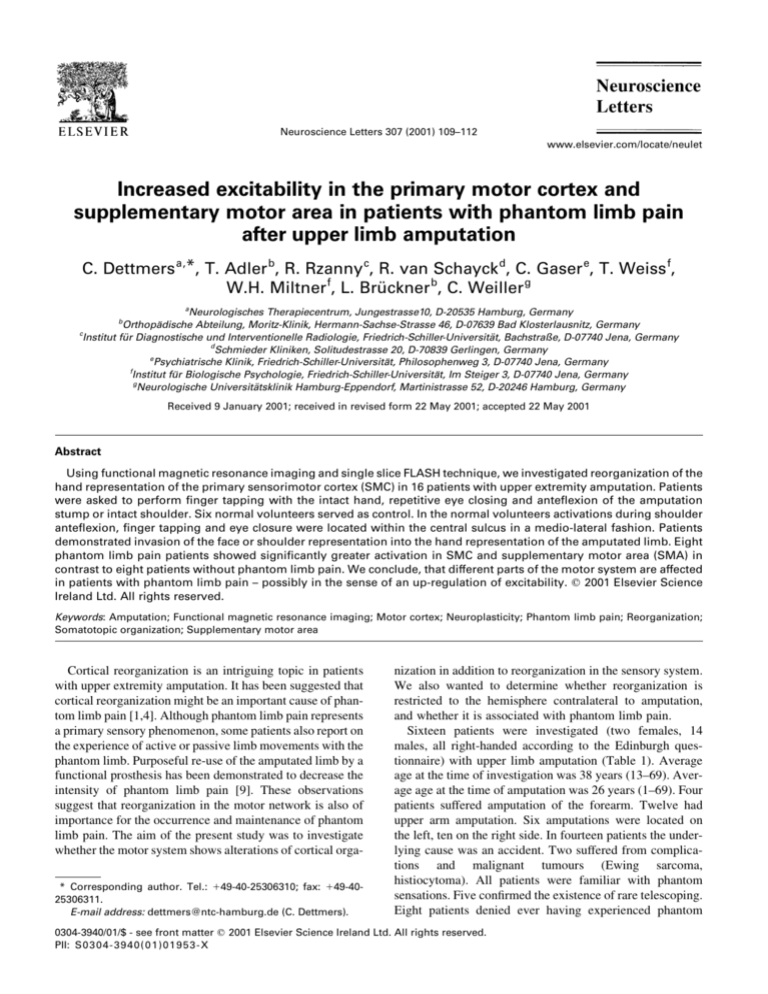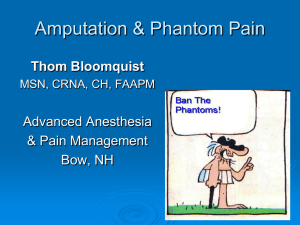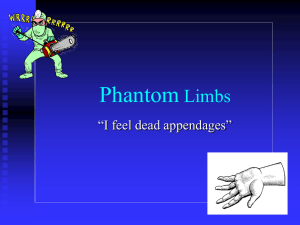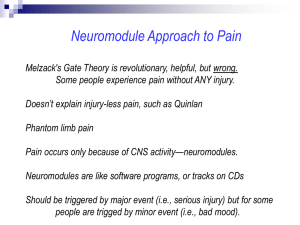
Neuroscience Letters 307 (2001) 109±112
www.elsevier.com/locate/neulet
Increased excitability in the primary motor cortex and
supplementary motor area in patients with phantom limb pain
after upper limb amputation
C. Dettmers a,*, T. Adler b, R. Rzanny c, R. van Schayck d, C. Gaser e, T. Weiss f,
W.H. Miltner f, L. BruÈckner b, C. Weiller g
a
Neurologisches Therapiecentrum, Jungestrasse10, D-20535 Hamburg, Germany
OrthopaÈdische Abteilung, Moritz-Klinik, Hermann-Sachse-Strasse 46, D-07639 Bad Klosterlausnitz, Germany
c
Institut fuÈr Diagnostische und Interventionelle Radiologie, Friedrich-Schiller-UniversitaÈt, Bachstraûe, D-07740 Jena, Germany
d
Schmieder Kliniken, Solitudestrasse 20, D-70839 Gerlingen, Germany
e
Psychiatrische Klinik, Friedrich-Schiller-UniversitaÈt, Philosophenweg 3, D-07740 Jena, Germany
f
Institut fuÈr Biologische Psychologie, Friedrich-Schiller-UniversitaÈt, Im Steiger 3, D-07740 Jena, Germany
g
Neurologische UniversitaÈtsklinik Hamburg-Eppendorf, Martinistrasse 52, D-20246 Hamburg, Germany
b
Received 9 January 2001; received in revised form 22 May 2001; accepted 22 May 2001
Abstract
Using functional magnetic resonance imaging and single slice FLASH technique, we investigated reorganization of the
hand representation of the primary sensorimotor cortex (SMC) in 16 patients with upper extremity amputation. Patients
were asked to perform ®nger tapping with the intact hand, repetitive eye closing and ante¯exion of the amputation
stump or intact shoulder. Six normal volunteers served as control. In the normal volunteers activations during shoulder
ante¯exion, ®nger tapping and eye closure were located within the central sulcus in a medio-lateral fashion. Patients
demonstrated invasion of the face or shoulder representation into the hand representation of the amputated limb. Eight
phantom limb pain patients showed signi®cantly greater activation in SMC and supplementary motor area (SMA) in
contrast to eight patients without phantom limb pain. We conclude, that different parts of the motor system are affected
in patients with phantom limb pain ± possibly in the sense of an up-regulation of excitability. q 2001 Elsevier Science
Ireland Ltd. All rights reserved.
Keywords: Amputation; Functional magnetic resonance imaging; Motor cortex; Neuroplasticity; Phantom limb pain; Reorganization;
Somatotopic organization; Supplementary motor area
Cortical reorganization is an intriguing topic in patients
with upper extremity amputation. It has been suggested that
cortical reorganization might be an important cause of phantom limb pain [1,4]. Although phantom limb pain represents
a primary sensory phenomenon, some patients also report on
the experience of active or passive limb movements with the
phantom limb. Purposeful re-use of the amputated limb by a
functional prosthesis has been demonstrated to decrease the
intensity of phantom limb pain [9]. These observations
suggest that reorganization in the motor network is also of
importance for the occurrence and maintenance of phantom
limb pain. The aim of the present study was to investigate
whether the motor system shows alterations of cortical orga* Corresponding author. Tel.: 149-40-25306310; fax: 149-4025306311.
E-mail address: dettmers@ntc-hamburg.de (C. Dettmers).
nization in addition to reorganization in the sensory system.
We also wanted to determine whether reorganization is
restricted to the hemisphere contralateral to amputation,
and whether it is associated with phantom limb pain.
Sixteen patients were investigated (two females, 14
males, all right-handed according to the Edinburgh questionnaire) with upper limb amputation (Table 1). Average
age at the time of investigation was 38 years (13±69). Average age at the time of amputation was 26 years (1±69). Four
patients suffered amputation of the forearm. Twelve had
upper arm amputation. Six amputations were located on
the left, ten on the right side. In fourteen patients the underlying cause was an accident. Two suffered from complications and malignant tumours (Ewing sarcoma,
histiocytoma). All patients were familiar with phantom
sensations. Five con®rmed the existence of rare telescoping.
Eight patients denied ever having experienced phantom
0304-3940/01/$ - see front matter q 2001 Elsevier Science Ireland Ltd. All rights reserved.
PII: S03 04 - 394 0( 0 1) 01 95 3- X
110
C. Dettmers et al. / Neuroscience Letters 307 (2001) 109±112
Table 1
Clinical characteristics of 16 patients with upper limb amputation
Patient Age at
study
Amputation Location
age
Side
Right Traumatic amputation
Right Infection of elbow
prosthesis
Right Accident
Right Traumatic destruction
Right Accident
Left
Traumatic destruction
Left
Pathological fracture
Left
Chronic osteomyelitis
Right Polytrauma
Right Traumatic amputation
Right Traumatic amputation
Right Traumatic destruction
Right Traumatic destruction
Left
Power current accident
Left
Traumatic nerve/vessel
destr.
Left
Traumatic destruction
1
2
48
33
48
31
Lower arm
Upper arm
3
4
5
6
7
8
9
10
11
12
13
14
15
29
44
49
59
69
58
37
13
29
25
44
16
22
18
31
31
59
69
23
37
11
8
16
13
15
7
Upper arm
Upper arm
Upper arm
Upper arm
Upper arm
Upper arm
Upper arm
Upper arm
Lower arm
Lower arm
Lower arm
Upper arm
Upper arm
16
39
1
Upper arm
Course
limb pain. Eight con®rmed occasional phantom limb pain
(Table 1). All patients were able to differentiate between
stump and phantom limb pain. At the time of the investigation no patient complained of pain.
A group of six, right-handed healthy volunteers (average
age 29, four males, two females) served as control. All
volunteers and patients signed an informed consent. The
study was in agreement with the Declaration of Helsinki.
A functional magnetic resonance imaging study was
performed using single slice FLASH technique and a Philips
Gyroscan ACS II (TR/TE/alpha 100/50/40)[2]. Measurements were performed in a transverse section between 45
and 55 mm dorsal and parallel to the anterior and posterior
commissure. The precise plane was identi®ed by the characteristic shape of the central sulcus of the unaffected hemisphere [10]. Slice thickness was 10 mm. One hundred
measurements were executed during ®ve different conditions: rest (A); tapping with the index ®nger and thumb of
the intact hand (B); ante¯exion of the intact arm (C); ante¯exion of the amputation stump (D); and repetitive eye
closure (E). Prior to scanning volunteers and patients were
carefully instructed and practiced to perform the movements
at a rate of about one Hz. Care was given that rate and
amplitude of the intact shoulder and stump movement or
right and left shoulder were similar. The philosophy of
choosing this particular plane was that it contains the cortical hand representation and that it is located between the
shoulder representation and the face representation.
Increased activation during face or shoulder movement
would suggest invasion of the neighbouring representations
into the cortical hand representation. Data from six patients
with left-sided amputation were mirrored at a sagittal plane
for group analysis, as if all patients had an amputation on the
left side. Data were analysed using SPM96 applying a
motion correction, a ®lter kernel of 3 mm for single subject
analysis and 6 mm for group analysis, and an ANCOVA [5].
Phantom
sensation
Telescoping
Phantom
pain
Shift of
Increased
representation activation
Yes
Yes
Discreet
Yes
Yes
Yes
Yes
No
Yes
No
Yes
Yes
Yes
Yes
Yes
Yes
Yes
Yes
Yes
Yes
Yes
Yes
Yes
Yes
Yes
Yes
Discreet
Discreet
Yes
Discreet
Yes
Yes
Yes
Yes
Discreet
Yes
Yes
Yes
Yes
Yes
Yes
Yes
No
No
No
No
No
No
No
Yes
No
No
Yes
No
No
No
No
No
No
Yes
Yes
Yes
Yes
Yes
Yes
Yes
No
No
Yes
No
Yes
No
Yes
Yes
Yes
Yes
Yes
No
Yes
Yes
Individual and group results are reported at P , 0:001. Data
were normalized on a standard template in this particular
plane for between-group comparison. Group results are
displayed as projection on an individual normalized plane.
Finger tapping induced an activation in the contralateral
sensorimotor cortex (SMC) in all volunteers. Activation was
located in all volunteers within the `knob' of the central
sulcus. In two volunteers repetitive eye closure caused a
small bilateral activation in the very lateral part of the
central sulcus, and one volunteer showed a unilateral activation. Ante¯exion of the right and left shoulder produced a
contralateral activation in four out of six cases. Activation
during shoulder ante¯exion was located mesial to the knob.
Finger tapping produced a `normal' activation in the
contralateral SMC in twelve patients. Three patients
presented a large activation in the contralateral SMC. Two
of these as well as another one showed a bilateral activation
of the SMC. Twelve patients showed some activation in
SMC during repetitive eye closure, predominantly in the
lateral part of the central sulcus. Five patients showed a
bilateral activation. Ante¯exion of the intact arm caused
several activation patterns. Activation was more frequent
in patients than in normal volunteers. Fifteen of sixteen
patients showed some activation in this particular transverse
plane during shoulder ante¯exion. The activation was extensive in nine patients during shoulder movements on either
side. In three patients activation was contralateral during
ante¯exion of the amputation stump, ipsilateral in one
patient and bilateral in another. Five patients showed an
activation in the contralateral SMC during ante¯exion of
the intact arm. One patient showed an activation ipsilateral
to the movement and another contralateral to amputation.
The activated focus was located more mesial to the `Omega'
of the central sulcus in ®ve patients.
Group analysis of all sixteen patients revealed an activation in the contralateral SMC and supplementary motor area
C. Dettmers et al. / Neuroscience Letters 307 (2001) 109±112
(SMA) during ®nger tapping and a weak activation during
repetitive eye closure. A strong activation in the mesial part
of the SMC and SMA was bilaterally generated during ante¯exion of the amputation stump. A strong activation was
induced in the contralateral SMC and SMA during ante¯exion of the intact shoulder.
Patients were divided into two groups: those who had
experienced phantom limb pain and those unfamiliar with
phantom limb pain. Patients with phantom limb pain
showed a very broad, extensive, bilateral activation in the
SMC and SMA during ante¯exion of the amputation stump
(Fig. 1, left panel). Patients without phantom limb pain
presented activation restricted to the mesial part of the
SMC contralateral to the amputation (Fig. 1, right panel).
Activation in the SMA during ante¯exion of the intact
shoulder was more likely in those patients with phantom
limb pain (Fig. 2, left panel) than in those without pain
(Fig. 2, right panel).
A between-group comparison in patients with phantom
limb pain and those without con®rmed an increased likelihood of activation in SMA ipsilateral to the stump during
ante¯exion of the stump (Fig. 3, left panel). Activation in
the contralateral SMC and ipsilateral SMA was more likely
during ante¯exion of the intact arm (Fig. 3, right panel). The
opposite contrast (patients without experience of phantom
limb pain versus those with experience) revealed no signi®cant activation.
The present results contain several important clues
regarding the organization of the motor system and the
generation of phantom limb pain:
The present data suggest that the central sulcus within this
Fig. 1. Categorical comparison between movement of the amputation stump and rest for patients with experience of phantom
limb pain (left panel) and without pain experience (right panel).
Signi®cant activations (P , 0:001) are displayed in white and
projected on the T1 weighted MRI image of a normalized individual. Left hemisphere (le) is displayed on the right side in radiological convention. Ante¯exion of the amputation stump in
patients with phantom limb pain (left panel) reveals an activation
of the contralateral shoulder representation within the primary
sensorimotor cortex (mesial to the hand representation within
the `inverted Omega') and a bilateral activation of the SMA. This
activation is much stronger in patients with phantom limb pain
than in those patients without phantom limb pain (right panel).
P , 0:001.
111
Fig. 2. Categorical group comparison between movement of the
intact shoulder in patients with the experience of phantom limb
pain and rest (left panel) and in patients without experience of
phantom limb pain (right panel). Ante¯exion of the intact
shoulder in patients with phantom limb pain (left panel) causes
an activation of the mesial part of the contralateral SMC and the
bilateral SMA. It causes an activation of the bilateral mesial part
of the SMC in patients without phantom limb pain (right panel).
P , 0:001.
particular transverse plane contains a speci®c topographical
organization: The face is represented in the very lateral part
of the central sulcus. The hand is represented in the middle,
within the `knob' of the sulcus. The shoulder is located on
its mesial side. This suggests the existence of a `partial
homunculus' within each transverse plane. We do not
suggest that this topographical organization is strict or
rigid. We assume that the functional organization, i.e. differ-
Fig. 3. Between-group comparison of activation in patients with
and without phantom limb pain for movements of the amputation stump (left panel) and the intact shoulder (right panel): Ante¯exion of the amputation stump causes a signi®cant (P , 0:001)
higher activation of the SMA ipsilateral to the stump in patients
with phantom limb pain compared to those without experience
of pain (left panel). Ante¯exion of the intact shoulder caused a
higher activation in the contralateral SMC and ipsilateral SMA in
patients with phantom limb pain compared to those with no
experience of phantom limb pain (right panel). Please note:
patients had no pain at the time of the investigation. The ®gure
illustrates that the motor cortex of patients with the experience
of phantom limb pain has a higher excitability than the motor
cortex in patients without phantom limb pain experience. The
reverse comparison (patients without phantom limb pain versus
patients with pain) did not indicate any signi®cant activation.
112
C. Dettmers et al. / Neuroscience Letters 307 (2001) 109±112
ent neural assemblies representing the function of grasping,
pinch grip etc., may still be dominant [7,8].
The motor system is affected in both hemispheres. There
is a shift of cortical representation into neighbouring areas.
There exists increased likelihood of activation in the hemisphere contralateral to the amputation stump. It has been
suggested that this activation re¯ects intracortical disinhibition. Furthermore, a similar increased activation was
observed in the hemisphere ipsilateral to amputation. This
may be explained by the lack of transcallosal or transhemispheric inhibition. It con®rms the close interaction between
both hemispheres [3,6]. A lesion or even a malfunction in
one hemisphere is likely to cause a malfunction in the opposite hemisphere.
Of particular interest is the increased activation of the
SMA in patients with phantom limb pain. There is a
systematic difference in age at amputation and age at scanning between both groups. This cannot be corrected for and
is in line with previous observations, that amputation at an
early age is less likely to produce phantom pain. Previous
investigations focused on the shift of cortical representations into neighbouring areas particularly in the primary
motor cortex, primary somatosensory cortex and parietal
cortex [1,4]. The present data con®rm this shift of representations within the motor cortex. Increased activation of
SMA, however, contains additional information and indicates that large parts of the motor system show increased
activity, probably due to an increase of excitability after
amputation of a limb. Increased excitability of the primary
motor cortex was recently con®rmed by single case studies
using transcranial magnetic stimulation [6]. Increased activation of SMA suggests that the motor system, in general, is
affected in patients with phantom limb pain. It is not clear,
whether increased excitability is the cause or consequence
of phantom limb pain. Its existence con®rms the role of the
motor system in the information process of pain. Our results
parallel recent observations that patients wearing a functional prosthesis rarely experience phantom limb pain [9].
It also underpins the value of physiotherapy or motor exercise in the treatment and prevention of phantom limb pain.
We are grateful to P.T. Alleyne-Dettmers, PhD, for text
editing.
[1] Birbaumer, N., Lutzenberger, W., Montoya, P., Larbig, W.,
Unertl, K., ToÈpfner, S., Grodd, W., Taub, E. and Flor, H.,
Effects of regional anesthesia on phantom limb pain are
mirrored in changes in cortical reorganization, J. Neurosci.,
17 (1997) 5503±5508.
[2] Dettmers, C., Connelly, A., Stephan, K.M., Turner, R., Friston, K.J., Frackowiak, R.S.J. and Gadian, D.G., Quantitative
comparison of functional magnetic resonance imaging and
positron emission tomography using a force-related paradigm, Neuroimage, 4 (1996) 201±209.
[3] Dettmers, C., Liepert, J., Adler, T., Rzanny, R., Rijntjes, M.,
van Schayck, R., Kaiser, W., BruÈckner, L. and Weiller, C.,
Abnormal motor cortex organization contralateral to early
upper limb amputation in humans, Neurosci. Lett., 263
(1999) 41±44.
[4] Flor, H., Elbert, T., Knecht, S., Wienbruch, C., Pantev, C.,
Birbaumer, N., Larbig, W. and Taub, E., Phantom-limb
pain as a perceptual correlate of cortical reorganization
following arm amputation, Nature, 375 (1995) 482±484.
[5] Friston, K.J., Holmes, A., Worsley, K.J., Poline, J.P., Frith,
C.D. and Frackowiak, R.S.J., Statistical parametric maps in
functional imaging: a general approach, Hum. Brain Mapp.,
2 (1995) 189±210.
[6] Hamzei, F., Liepert, J., Dettmers, C., Adler, T., Kiebel, S.,
Rijntjes, M. and Weiller, C., Structural and functional
abnormalities after upper limb amputation during childhood, NeuroReport, 12 (2001) 957±962.
[7] Schieber, M.H., Somatotopic gradients in the distributed
organization of the human primary motor cortex hand
area: evidence from small infarcts, Exp. Brain Res., 128
(1999) 139±148.
[8] Schott, G.D., Pen®eld's homunculus: a note on cerebral
cartography, Neurol. Neurosurg. Psychiat., 56 (1993) 329±
333.
[9] Weiss, T., Miltner, W.H., Adler, T., BruÈckner, L. and Taub, E.,
Decrease in phantom limb pain associated with prosthesisinduced increased use of an amputation stump in humans,
Neurosci. Lett., 272 (1999) 131±134.
[10] Yousry, T.A., Schmid, D.U., Alkadhi, H., Schmidt, D.,
Peraud, A., Buettner, A. and Winkler, P., Localization of
the motor hand area to a knob on the precentral gyrus. A
new landmark, Brain, 120 (1997) 141±157.







